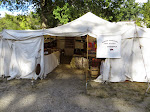I would like to conclude my series on buttons by covering some other common types of buttons.
Vegetable Ivory
First on my list are vegetable ivory buttons. Vegetable ivory comes from the Tagua nut that grows on trees in South America. This nut can be carved and finished to a fine ivory like finish. They are very dense and dye does not penetrate. Typically the button holes were drilled after they were dyed, so frequently you can tell a VI button by looking at the back. Sometimes you can also see some graining.
Tagua Nuts
Back of a Vegetable Ivory Button showing the dyed and undyed surfaces.
Tagua Nuts
Back of a Vegetable Ivory Button showing the dyed and undyed surfaces.
These buttons made their appearance at the 1862 Universal Exposition in Paris and were quite common between 1870 and 1920.1 This material was a cheaper, more abundant substitute for real ivory. A resurrection of this type of button just might help save the rainforest by giving South American farmers an income from these nuts, thus encouraging them to plant more trees.
Some exquisite vegetable ivory whistles
Some exquisite vegetable ivory whistles
Horn Buttons
Another natural material for making buttons is horn. Horn can be heated and pressed into a mold, and thus able to be formed in intricate designs. One of the tell-tale marks of a horn button is located on the back. Often there is a pick mark in the back where it was pried from the mold
Buffalo horn buttons (whistles) showing front and back. You can see the faint pick mark between the holes on the back.
Perfume Buttons
Perfume buttons were made for…you guessed it, perfume. In the 19th century perfume was oil based, rather than alcohol based. Women were justifiably concerned about perfume staining their clothing so they used metal buttons with velvet, fabric or hair inserts to place their perfume on. When the men went off to war a woman might give him one of her perfume buttons to sew underneath his collar so that he could carry her scent with him.
Metal Buttons
My series would not be complete without mentioning metal buttons. The Victorian Era was noted for being ornate. Many of the metal buttons of the period reflected this ornateness. They exhibited their love of the arts with picture buttons portraying stories. These buttons have become very collectible, some of them bringing upwards of $75 or more. Most of the older buttons have a shank on the back.
Metal buttons showing the picture (although this is a rather simple example) and the back, showing the shank.
Metal buttons showing the picture (although this is a rather simple example) and the back, showing the shank.
1 Sisters Vintage Button Accessories, http://www.kk-design.com/scti/in103/students/buttons/button_project/button%20types/types.htm















